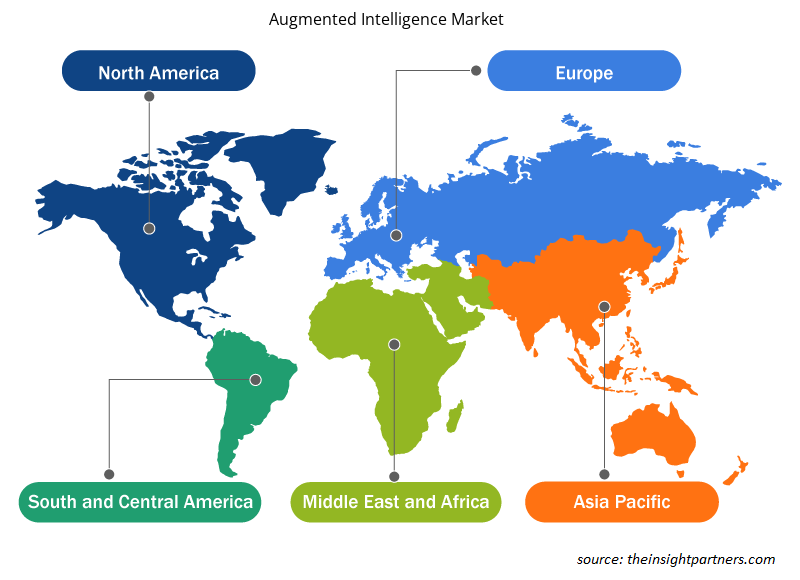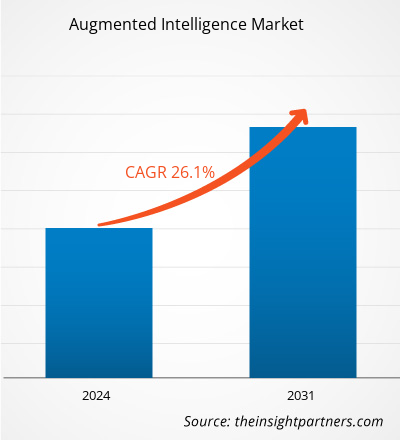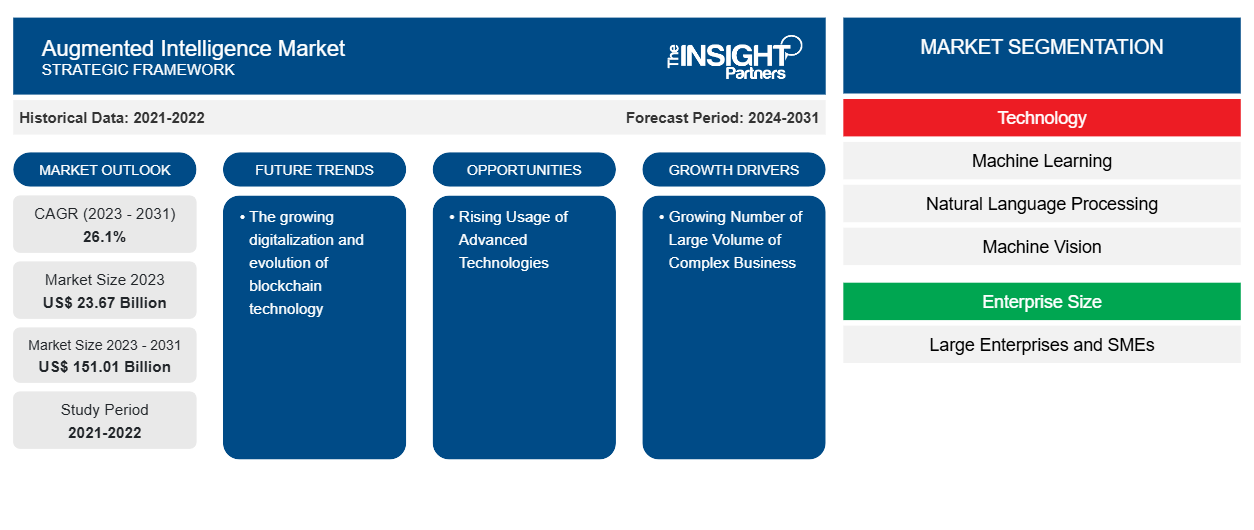Si prevede che la dimensione del mercato dell'intelligenza aumentata raggiungerà 151,01 miliardi di dollari entro il 2031, rispetto ai 23,67 miliardi di dollari del 2023. Si prevede che il mercato registrerà un CAGR del 26,1% nel 2023-2031. La crescente digitalizzazione e l'evoluzione della tecnologia blockchain rimarranno probabilmente una tendenza chiave del mercato dell'intelligenza aumentata.CAGR of 26.1% in 2023–2031. The growing digitalization and evolution of blockchain technology are likely to remain a key augmented intelligence market trend.
Analisi di mercato dell'intelligenza aumentata
Il mercato dell'intelligenza aumentata sta crescendo a un ritmo rapido a causa del crescente numero di grandi volumi di dati aziendali complessi e dell'espansione dei settori BFSI, IT e telecomunicazioni, vendita al dettaglio ed e-commerce. Il mercato si sta espandendo costantemente, guidato dalla crescente adozione dell'intelligenza aumentata tra le PMI. Inoltre, il crescente utilizzo di tecnologie avanzate e la crescente adozione di soluzioni basate su cloud tra le aziende stanno offrendo opportunità redditizie per la crescita del mercato.
Panoramica del mercato dell'intelligenza aumentata
L'intelligenza aumentata è un tipo di intelligenza artificiale che si concentra sulle capacità assistive dell'IA. Inoltre, l'intelligenza aumentata viene creata per supportare le organizzazioni nel prendere decisioni basate sui dati più accurate nel business e nella vita quotidiana. Inoltre, l'intelligenza aumentata viene utilizzata dalle aziende per migliorare le prestazioni dei dipendenti e aiuta l'organizzazione a comprendere le aree di miglioramento dei dipendenti che guidano il mercato. Inoltre, l'intelligenza aumentata è la tecnica più efficace per utilizzare e dare priorità a una grande raccolta di dati sulla sicurezza fornendo analisi predittive alle aziende.
Personalizza questo report in base alle tue esigenze
Riceverai la personalizzazione gratuita di qualsiasi report, comprese parti di questo report, o analisi a livello nazionale, pacchetto dati Excel, oltre a usufruire di grandi offerte e sconti per start-up e università
-
Scopri le principali tendenze di mercato in questo rapporto.Questo campione GRATUITO includerà analisi di dati che spaziano dalle tendenze di mercato alle stime e alle previsioni.
Driver e opportunità del mercato dell'intelligenza aumentata
Il crescente numero di grandi volumi di dati aziendali complessi sta guidando il mercato
Le tecnologie di intelligenza aumentata, come l'apprendimento automatico e l'elaborazione del linguaggio naturale, stanno diventando sempre più importanti per l'analisi dei dati. L'intelligenza aumentata consente l'analisi di fonti di dati organizzate, semi-strutturate e non strutturate archiviate all'interno delle aziende. Si prevede che la varietà e l'elevato volume di dati creati aumenteranno in modo significativo nei prossimi anni, associati all'espansione dei settori e all'evoluzione delle tecnologie digitali nelle operazioni aziendali. Ciò aumenta la domanda di soluzioni di intelligenza aumentata tra le aziende per gestire in modo efficace ed efficiente il loro ampio volume di dati. Tuttavia, si prevede che il crescente volume di dati complicati alimenterà il mercato dell'intelligenza aumentata durante il periodo di tempo previsto.
Crescente utilizzo di tecnologie avanzate: un’opportunità nel mercato dell’intelligenza aumentata
L'uso crescente di tecnologie avanzate come l'intelligenza artificiale, l'apprendimento automatico e le tecnologie di elaborazione del linguaggio naturale stanno creando opportunità di crescita del mercato durante il periodo di previsione. Molti settori, come IT e telecomunicazioni, vendita al dettaglio ed e-commerce, BFSI, assistenza sanitaria e altri, stanno generando enormi volumi di dati e richiedono tecnologie avanzate per analizzare questi dati in tempo reale, il che aumenta la domanda di soluzioni di intelligenza aumentata. I settori stanno adottando nuove tecnologie come l'intelligenza artificiale, l'apprendimento automatico e l'elaborazione del linguaggio naturale per analizzare grandi quantità di dati prendendo decisioni efficaci in tempo reale. Questi strumenti hanno semplificato il processo di estrazione di informazioni dai dati, il che ne aumenta l'adozione e crea opportunità nel mercato.BFSI, healthcare, and others, are generating vast volumes of data and require advanced technologies for analyzing this data in real-time, which increases the demand for augmented intelligence solutions. Industries are adopting new technologies such as artificial intelligence, machine learning, and natural language processing for analyzing vast data by making effective decisions in real time. These tools have simplified the process of extracting insights from data, which increases its adoption and creates opportunities in the market.
Analisi della segmentazione del rapporto di mercato dell'intelligenza aumentata
I segmenti chiave che hanno contribuito alla derivazione dell'analisi di mercato dell'intelligenza aumentata sono la tecnologia, le dimensioni dell'impresa e l'utente finale
- In base alla tecnologia, il mercato dell'intelligenza aumentata è suddiviso in apprendimento automatico, elaborazione del linguaggio naturale, visione artificiale, elaborazione basata sul contesto e altri. Il segmento dell'apprendimento automatico ha detenuto una quota di mercato maggiore nel 2023.
- In termini di dimensioni aziendali, il mercato è segmentato in grandi imprese e PMI. Il segmento PMI ha detenuto una quota di mercato maggiore nel 2023.
- In termini di utente finale, il mercato è categorizzato come IT e telecomunicazioni, vendita al dettaglio ed e-commerce, BFSI, assistenza sanitaria e altri. Il segmento BFSI ha detenuto una quota di mercato maggiore nel 2023.
Analisi della quota di mercato dell'intelligenza aumentata per area geografica
L'ambito geografico del rapporto sul mercato dell'intelligenza aumentata è suddiviso principalmente in cinque regioni: Nord America, Asia Pacifico, Europa, Medio Oriente e Africa e Sud America/Sud e Centro America.
In termini di fatturato, il Nord America ha rappresentato la quota di mercato più grande dell'intelligenza aumentata, grazie al progresso tecnologico e alla presenza di attori chiave, tra cui IBM Corporation, Microsoft Corporation, TIBCO Software Inc., Salesforce.com, Inc. e MicroStrategy Incorporated. Questi attori stanno investendo in modo significativo nell'adozione di tecnologie avanzate come AI, ML e NLP e sono costantemente impegnati nello sviluppo di queste tecnologie aggiungendo funzionalità aggiuntive. Si prevede che la crescente domanda di intelligenza aumentata basata su cloud tra settori tra cui IT e telecomunicazioni , BFSI, vendita al dettaglio ed e-commerce, assistenza sanitaria e altri stimolerà il mercato nel Nord America.
Approfondimenti regionali sul mercato dell'intelligenza aumentata
Le tendenze regionali e i fattori che influenzano il mercato dell'Augmented Intelligence durante il periodo di previsione sono stati ampiamente spiegati dagli analisti di Insight Partners. Questa sezione discute anche i segmenti e la geografia del mercato dell'Augmented Intelligence in Nord America, Europa, Asia Pacifico, Medio Oriente e Africa e America meridionale e centrale.

- Ottieni i dati specifici regionali per il mercato dell'intelligenza aumentata
Ambito del rapporto di mercato sull'intelligenza aumentata
| Attributo del report | Dettagli |
|---|---|
| Dimensioni del mercato nel 2023 | 23,67 miliardi di dollari USA |
| Dimensioni del mercato entro il 2031 | 151,01 miliardi di dollari USA |
| CAGR globale (2023-2031) | 26,1% |
| Dati storici | 2021-2022 |
| Periodo di previsione | 2024-2031 |
| Segmenti coperti |
Per tecnologia
|
| Regioni e Paesi coperti |
America del Nord
|
| Leader di mercato e profili aziendali chiave |
|
Densità degli attori del mercato dell'intelligenza aumentata: comprendere il suo impatto sulle dinamiche aziendali
Il mercato dell'Augmented Intelligence Market sta crescendo rapidamente, spinto dalla crescente domanda degli utenti finali dovuta a fattori quali l'evoluzione delle preferenze dei consumatori, i progressi tecnologici e una maggiore consapevolezza dei vantaggi del prodotto. Con l'aumento della domanda, le aziende stanno ampliando le loro offerte, innovando per soddisfare le esigenze dei consumatori e capitalizzando sulle tendenze emergenti, il che alimenta ulteriormente la crescita del mercato.
La densità degli operatori di mercato si riferisce alla distribuzione di aziende o società che operano in un particolare mercato o settore. Indica quanti concorrenti (operatori di mercato) sono presenti in un dato spazio di mercato in relazione alle sue dimensioni o al valore di mercato totale.
Le principali aziende che operano nel mercato dell'intelligenza aumentata sono:
- Società IBM
- Società Microsoft
- SAP SE
- Azienda: TIBCO Software Inc.
- Società
- Salesforce.com, Inc.
Disclaimer : le aziende elencate sopra non sono classificate secondo un ordine particolare.

- Ottieni una panoramica dei principali attori del mercato dell'intelligenza aumentata
Notizie di mercato e sviluppi recenti dell'intelligenza aumentata
Il mercato dell'intelligenza aumentata viene valutato raccogliendo dati qualitativi e quantitativi dopo la ricerca primaria e secondaria, che includono importanti pubblicazioni aziendali, dati associativi e database. Di seguito è riportato un elenco degli sviluppi nel mercato dell'intelligenza aumentata e delle strategie:
- A settembre 2023, Oracle Corp ha presentato oggi nuove funzionalità basate sull'intelligenza artificiale all'interno di Oracle Analytics Cloud. Le nuove funzionalità di intelligenza artificiale self-service, tra cui assistenti AI generativi e analisi aumentata, aiutano le organizzazioni a migliorare il modo in cui i dati influenzano il processo decisionale. (Fonte: Oracle Corp, comunicato stampa, 2023)
Copertura e risultati del rapporto di mercato sull'intelligenza aumentata
Il rapporto “Dimensioni e previsioni del mercato dell’intelligenza aumentata (2021-2031)” fornisce un’analisi dettagliata del mercato che copre le seguenti aree:
- Dimensioni e previsioni del mercato a livello globale, regionale e nazionale per tutti i segmenti di mercato chiave coperti dall'ambito
- Dinamiche di mercato come fattori trainanti, vincoli e opportunità chiave
- Principali tendenze future
- Analisi dettagliata delle cinque forze PEST/Porter e SWOT
- Analisi di mercato globale e regionale che copre le principali tendenze di mercato, i principali attori, le normative e gli sviluppi recenti del mercato
- Analisi del panorama industriale e della concorrenza che copre la concentrazione del mercato, l'analisi della mappa di calore, i principali attori e gli sviluppi recenti
- Profili aziendali dettagliati
- Analisi storica (2 anni), anno base, previsione (7 anni) con CAGR
- Analisi PEST e SWOT
- Valore/volume delle dimensioni del mercato - Globale, Regionale, Nazionale
- Industria e panorama competitivo
- Set di dati Excel
Report recenti
Testimonianze
Motivo dell'acquisto
- Processo decisionale informato
- Comprensione delle dinamiche di mercato
- Analisi competitiva
- Analisi dei clienti
- Previsioni di mercato
- Mitigazione del rischio
- Pianificazione strategica
- Giustificazione degli investimenti
- Identificazione dei mercati emergenti
- Miglioramento delle strategie di marketing
- Aumento dell'efficienza operativa
- Allineamento alle tendenze normative























 Ottieni un campione gratuito per - Mercato dell'intelligenza aumentata
Ottieni un campione gratuito per - Mercato dell'intelligenza aumentata